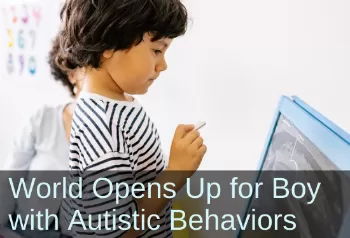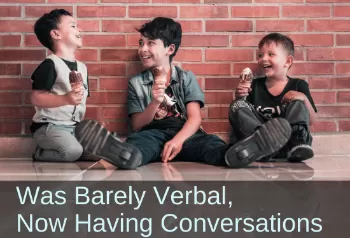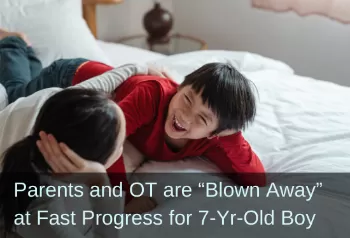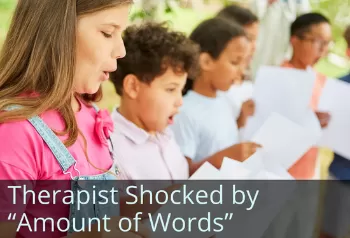Autism (ASD)
Transforming Autism Symptoms with Neurodevelopmental Movements
by Sonia Story, M.S.
Parents and professionals consistently report that neurodevelopmental movements—rhythmic movements, primitive reflexes, postural reflexes, and developmental movements—are helping with sensory issues, motor challenges, sleep issues, emotional regulation, and anxiety. These are all challenges that individuals with autism (ASD) commonly experience. The innate movements from the Brain and Sensory Foundations courses offer profound help for those with ASD. Here is some of the supporting evidence and reasoning behind this hopeful message.
Preliminary evidence shows that the use of primitive reflex movement patterns may be particularly helpful in cases of autism (Melillo et al., 2022; Masgutova et al., 2016). Viewpoints of practitioners serving autistic children are also important to consider.
In this video interview, Peggy McCahan, occupational therapy assistant, reports on her success using only passively applied rhythmic movements from the Brain and Sensory Foundations program for children with ASD, ages 8 to 12, in a self-contained classroom. McCahan spearheaded the implementation of four passive rhythmic movements (one-minute each for a total of four minutes a day) five days per week for 10 children, 8 of which were diagnosed with ASD. Baseline data in the form of occupational therapy goals were written for each student. The total time for intervention was from August 22, 2022 to October 3, 2022. Due to staff shortages, the children were receiving no other occupation-based therapy during this time. At the end of the school quarter, students were reassessed on their occupational therapy goals. McCahan found that all students made progress on their occupational therapy goals. Some students made progress to such an extent that they needed new goals. [McCahan, video interview, March, 24, 2023]
Similar outcomes have been reported by many other therapy professionals. Upon using a combination of innate rhythmic movements and primitive reflex integration, Carrie Eskenazi, SLP, stated:
“I have seen astounding changes in relatively short periods of time: children with little to no language, who now have conversations with me; children who could not sit still for more than 2 seconds, who now sit in groups with others and listen carefully; children with many phobias and fears, who now participate in their school day with joy.” (Eskenazi, C., email communication, October, 27, 2023).
There is a decades-long history of research showing that autism is associated with motor deficits (Odeh et al., 2022; Gong et al., 2020; Torres & Whyatt, 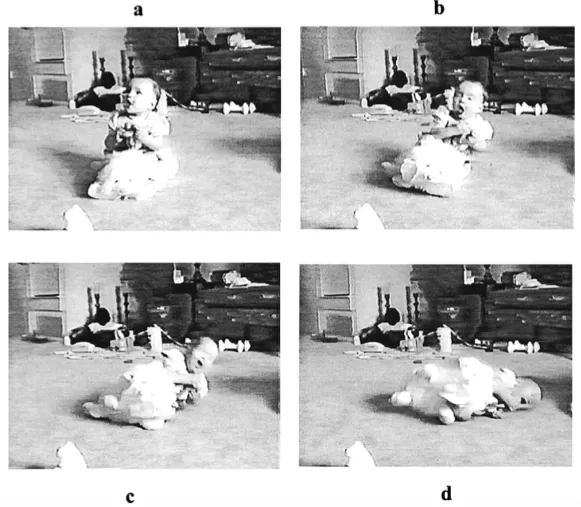 Photos from Teitlebaum et al., 1998: An autistic girl, 8.5 months old, shows no allied protective reflexes when falling (e.g., extending the arms and hands out to protect herself from striking her head when falling toward the ground).2018; McPhillips et al., 2014; Teitelbaum et al., 2002, Teitelbaum et al., 1998; Kohen-raz et al., 1992).
Photos from Teitlebaum et al., 1998: An autistic girl, 8.5 months old, shows no allied protective reflexes when falling (e.g., extending the arms and hands out to protect herself from striking her head when falling toward the ground).2018; McPhillips et al., 2014; Teitelbaum et al., 2002, Teitelbaum et al., 1998; Kohen-raz et al., 1992).
This research is important because:
- It supports the idea that we can use innate movements to help with early detection of risk for autism.
- We can work to improve motor control, thereby opening the possibility of improving functional skills as well as sensory comfort in other areas of life.
In one noteworthy study researchers showed that abnormal gait patterns are common for individuals with Autism (ASD), and abnormal gait is correlated with social impairments (Gong et al., 2020).
Since proper gait is developed in infancy largely via the action of innate neurodevelopmental movements, it is very possible that the abnormal gait in individuals with ASD is related to a lack of these all important innate movements during infancy. For example, toe walking, a common behavior in autism, is associated with a retained Tonic Labyrinthine Reflex (Accardo & Barrow, 2015). Pelvic asymmetry and poor gait are associated with a retained asymmetric tonic neck reflex (Gieysztor et al., 2020).
So the important question is: When we give these innate movements later in life, can it still help with gait and with corresponding social-emotional skills?
So far, in case study reports we are seeing a big Yes answer to this question. Many therapists using tools from the Brain and Sensory Foundations courses notice that after doing innate rhythmic movements and reflex integration, children's gait often improves along with their ability to produce a proper "heel strike" when walking. These movements also appear to help reduce and eliminate toe walking! Countless parents and therapists have also reported that children are more emotionally regulated and more able to connect socially—often in very touching ways—after receiving these innate movements.
One 11-year-old boy with an awkward gait, flat affect, and learning challenges started to walk with a coordinated gait within a week of doing the innate rhythmic movements and reflex integration. Within 3 months, the boy was laughing and talking with friends, learning with more ease, and sharing loving expressions with his parents—something he had never done before. [Paraphrased from a case study by Laura Parker of Hands-On Learning Solutions].
Read the case studies below to see how these innate neurodevelopmental movements are helping individuals overcome struggles with many of the symptoms of autism—and how their lives are easier and more joyful because of it.
This young boy was focused on trains to the exclusion of other activities, and refused to read or write. He now plays with his brother, explores books, and is starting to draw. He's even trying new foods! Find out how rhythmic movements and innate reflex integration addressed his autistic behaviors and developmental delay.
This 4-yr-old boy could not respond to his name or make eye contact, and struggled with learning, sleeping, and playing with others. This case study shows how rhythmic movements and primitive reflex integration can help with autistic behaviors, and attention, learning, and social issues.
The tools from the Brain and Sensory Foundations course made a huge difference for this 7-year-old boy. Learn how rhythmic movements and primitive reflex inegration helped stop his head-slapping and thumb-sucking, as well as improved his fine- and gross-motor skills.
See more inspiring stories on our autism case studies page.
References
Accardo, P. J., & Barrow, W. (2015). Toe walking in autism: Further observations. Journal of Child Neurology, 30(5), 606-609.
Gieysztor, E., Pecuch, A., Kowal, M., Borowicz, W., & Paprocka-Borowicz, M. (2020). Pelvic symmetry is influenced by asymmetrical tonic neck reflex during young children’s gait. International Journal of Environmental Research and Public Health, 17(13), 4759.
Gong, L., Liu, Y., Yi, L., Fang, J., Yang, Y., & Wei, K. (2020). Abnormal gait patterns in autism spectrum disorder and their correlations with social impairments. Autism Research, 13(7), 1215-1226.
Kohen-Raz, R., Volkman, F. R., & Cohen, D. J. (1992) Postural control in children with autism. Journal of Autism and Developmental Disorders, 22(3), 419-432. doi:10.1007/bf01048244
McPhillips, M., Finlay, J., Bejerot, S., & Hanley, M. (2014). Motor deficits in children with autism spectrum disorder: A cross‐syndrome study.
Odeh, C. E., Gladfelter, A. L., Stoesser, C., & Roth, S. (2022). Comprehensive motor skills assessment in children with autism spectrum disorder yields global deficits. International Journal of Developmental Disabilities, 68(3), 290-300.
Teitelbaum, P., Teitelbaum, O., Nye, J., Fryman, J., & Maurer, R. G. (1998). Movement analysis in infancy may be useful for early diagnosis of autism. Proceedings of the National Academy of Sciences of the United States of America, 95(23), 13982–13987.
Teitelbaum, P., Teitelbaum, O. B., Fryman, J., & Maurer, R. (2002). Reflexes gone astray in autism in infancy. Journal of Developmental and Learning Disorders, 6, 15-22. Find a copy of this study here:
Torres, E.B. (Editor); Whyatt, C. (Editor) (2018). Autism: The Movement-Sensing Perspective, ISBN 9780367657666,
CRC Press.
Sonia Story, M.S. has been teaching neurodevelopmental movements since 2006.
Sonia developed the Brain and Sensory Foundations program to provide comprehensive training in neurodevelopmental movements—combining innate rhythmic movements, play, primitive reflexes, and postural reflexes.
She earned a Bachelor's degree in biology/psychology and a Master’s degree in Movement Sciences. She is the author of The Importance of Reflex Integration and the Evidence eBook, giving the rationale and evidence basis for using neurodevelopmental movements for helping with challenges such as ADHD, Sensory Processing Disorders, anxiety, emotional dysregulation, visual skill deficits, poor social skills, gross and fine motor delays and other neurodevelopmental and behavioral disorders.
Her work is featured in numerous podcasts, summits, and conferences, and in the books Almost Autism: Recovering Children from Sensory Processing Disorder; Special Ed Mom Survival Guide; Family Health Revolution; and Same Journey, Different Paths—Stories of Auditory Processing Disorder.
Sonia’s mission is to help children and families experience the profound benefits of neurodevelopmental and integrative movements for more functional and fulfilling lives.


